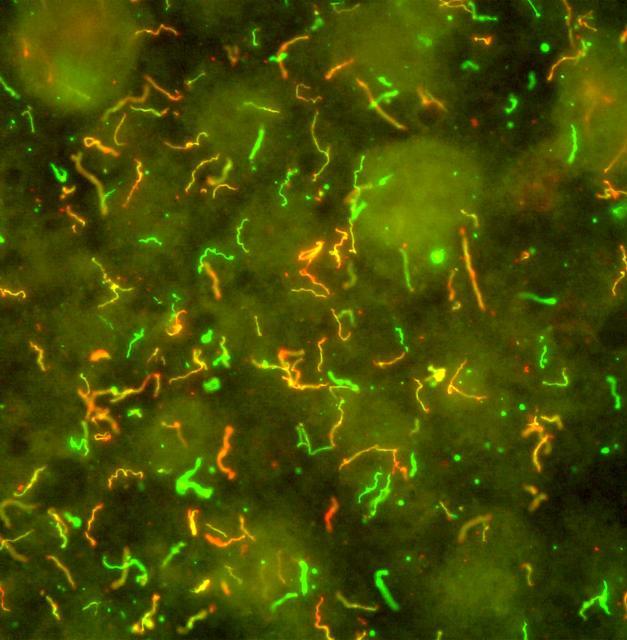Scientists work toward a rapid point-of-care diagnostic test for Lyme disease

In this image, the spiral-shaped bacteria which cause Lyme disease, Borrelia burgdorferi, have been illuminated using red and green fluorescent antibodies. Credit: NIAID
Lyme disease is caused by Borrelia burgdorferi, a spiral-shaped bacterium transmitted by deer ticks. Most cases of Lyme disease can be treated effectively with a short course of antibiotics. However, Lyme disease can be difficult to diagnose because it causes a wide range of symptoms, from fever and rash to neurologic and cardiac symptoms and joint pain.
Current Lyme disease tests also can miss an infection if performed too early. The Centers for Disease Control and Prevention recommends a two-step blood test for diagnosing Lyme disease that looks for antibodies against Lyme disease.
These tests require specialized laboratory equipment and can require days or weeks to return results. The authors of the paper plan to develop a simpler, faster, more sensitive test that could be used at the point of care during a single visit to a healthcare provider.
The researchers first screened a set of known Lyme disease biomarkers for their ability to indicate infection. They then tested for the top three biomarkers on samples from people with early Lyme disease, from healthy individuals from areas where Lyme disease is endemic, and from people with Lyme arthritis. This was compared to results obtained using the standard two-step testing procedure.
Overall, the new set of biomarkers was more sensitive than standard Lyme disease tests. These biomarkers were better at picking up signs of Lyme disease infection in early stage samples–possibly because they were able to detect antibodies that peak in the first two to six weeks after a person is infected with Lyme disease.
These results open the possibility of developing a point-of-care test for Lyme disease. While the assay will require more refinement and testing before it can be approved by the Food and Drug Administration for widespread use as a simple diagnostic test for Lyme disease, the researchers say that these results show great potential.
ARTICLE:
Arumugam et al. A multiplexed serologic test for diagnosis of Lyme disease for point-of-care use. Journal of Clinical Microbiology DOI: 10.1128/JCM.01142-19 (2019).
WHO:
Adriana Marques, M.D., chief of the Lyme Disease Studies Unit in the Laboratory of Clinical Immunology & Microbiology at NIAID and an author of this study, is available for comment.
This research was supported in part by NIAID grant R44 AI096551 and in part by NIAID's Intramural Research Program.
CONTACT:
To schedule interviews, please contact Elizabeth Deatrick, (301) 402-1663, elizabeth.deatrick@nih.gov.
NIAID conducts and supports research–at NIH, throughout the United States, and worldwide–to study the causes of infectious and immune-mediated diseases, and to develop better means of preventing, diagnosing and treating these illnesses. News releases, fact sheets and other NIAID-related materials are available on the NIAID website.
About the National Institutes of Health (NIH): NIH, the nation's medical research agency, includes 27 Institutes and Centers and is a component of the U.S. Department of Health and Human Services. NIH is the primary federal agency conducting and supporting basic, clinical, and translational medical research, and is investigating the causes, treatments, and cures for both common and rare diseases. For more information about NIH and its programs, visit http://www.
NIH…Turning Discovery Into Health®
Media Contact
More Information:
http://dx.doi.org/10.1128/JCM.01142-19All latest news from the category: Health and Medicine
This subject area encompasses research and studies in the field of human medicine.
Among the wide-ranging list of topics covered here are anesthesiology, anatomy, surgery, human genetics, hygiene and environmental medicine, internal medicine, neurology, pharmacology, physiology, urology and dental medicine.
Newest articles

Superradiant atoms could push the boundaries of how precisely time can be measured
Superradiant atoms can help us measure time more precisely than ever. In a new study, researchers from the University of Copenhagen present a new method for measuring the time interval,…

Ion thermoelectric conversion devices for near room temperature
The electrode sheet of the thermoelectric device consists of ionic hydrogel, which is sandwiched between the electrodes to form, and the Prussian blue on the electrode undergoes a redox reaction…

Zap Energy achieves 37-million-degree temperatures in a compact device
New publication reports record electron temperatures for a small-scale, sheared-flow-stabilized Z-pinch fusion device. In the nine decades since humans first produced fusion reactions, only a few fusion technologies have demonstrated…





















